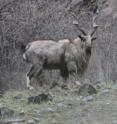Wildlife Conservation Society documents pneumonia outbreak in endangered markhor
If they didn't have enough to worry about from dodging poachers, snow leopards, and landslides in Central Asia's rugged mountains, a population of endangered markhor -- a majestic wild goat species -- has contracted pneumonia, detected for the first time by the Wildlife Conservation Society and partners in Tajikistan and France. Markhor are known for their impressive corkscrew horns that can reach nearly five feet in length, and their spectacular climbing ability that enables them to climb cliffs -- and despite their large size, even trees -- to feed. The pneumonia outbreak, which occurred in Tajikistan during September and October of 2010, is believed to have killed at least 65 markhors -- as much as 20 percent of the population remaining in the country. Fewer than 2,500 markhor exist across their entire range.
The study appears in the December issue of the journal Emerging Infectious Diseases. Authors include Stéphane Ostrowski of the Wildlife Conservation Society; Francois Thiaucourt, Lucía Manso-Silván, and Virginie Dupuy of Centre de Coopération International en Recherche Agronomique pour le Développement of Montpellier, France; Mulojon Amirbekov, Abdurahmon Mahmadshoev, and Orom Ziyoev of Tajikistan's Ministry of Agriculture; Dustmurod Vahobov of the Tajikistan's Academy of Agricultural Sciences; and Stefan Michel of Tajikistan's Nature Protection Team. The work was supported in part by the German federal agency for international cooperation (Deutsche Gesellschaft für Internationale Zusammenarbeit).
The authors of the study believe that the markhor may have contracted the disease from domestic goats. Raising goats in habitats used by markhor is a necessity for local communities with few other livelihood options. This cohabitation increases the risk of transmission of infectious agents from domestic stock to wildlife.
The authors believe that a newly recorded pathogen in markhor may be responsible for the pneumonia outbreak. The case emphasizes the need for continuous disease surveillance in domestic animals that have contact with valuable wildlife resources, the authors said.
"So far, no new outbreaks have been reported since 2010," said Dr. Ostrowski, lead author on the study. "Recent investigations in the area of the outbreak have revealed that domestic goats test positive for a Mycoplasma bacteria that may cause pneumonia in both domestic and wild goats. The Nature Protection Team, a Tajik nongovernmental organization, is working with communities to minimize contacts between domestic animals and markhor."
WCS has been leading efforts to save the remarkable markhor across its range. In the mountains of northern Pakistan, WCS now works with more than 20 communities to stop poaching and train community rangers to monitor markhor and enforce local hunting bans. In Afghanistan, WCS recently conducted wildlife surveys along the border of Tajikistan and discovered previously unrecorded populations of markhor in the Badakhshan Province. WCS, with funding from the American Association for the Advancement of Science (AAAS), is also bringing together health officials in Tajikistan, Afghanistan, and Pakistan to assess disease threats to markhor and other wildlife in the region.
Source: Wildlife Conservation Society
Other sources
- Pneumonia outbreak in endangered markhor goatsfrom Science DailyMon, 9 Jan 2012, 2:30:23 UTC
- Pneumonia wiped out 20% of rare wild goatsfrom MSNBC: ScienceSat, 7 Jan 2012, 0:00:31 UTC
- Pneumonia Outbreak Killed 20% of Rare Goat Speciesfrom Live ScienceFri, 6 Jan 2012, 19:00:33 UTC
- WCS documents pneumonia outbreak in endangered markhorfrom PhysorgThu, 5 Jan 2012, 18:30:36 UTC
